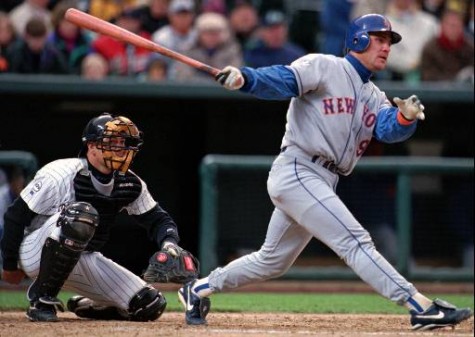Opening Day 2011 will be the 50th Opening Day in Mets history. To honor that, around here we’ll be counting down the top 50 Mets in team history, one every weekday from now until we’ve done ‘em all. Today, #34, Todd Hundley:
“Radomski has known Hundley since 1988, when Radomski worked for the Mets and Hundley played in the Mets’ minor league system. Radomski stated that, beginning in 1996, he sold Deca-Durabolin and testosterone to Hundley on three or four occasions. At the beginning of that year, Radomski told Hundley that if he used steroids, he would hit 40 home runs. Hundley hit 41 home runs in 1996, having never hit more than 16 in any prior year. After the season, Radomski said, Hundley took him out to dinner.”
– The Mitchell Report, Page 211
How much did using steroids actually help Todd Hundley? As the Mitchell report points out, Hundley had never hit more than 16 home runs in a season before his 41 home run outburst in 1996, the same year he allegedly began using steroids. It’s like finding a plate of cookies on the floor next to your passed out dog (or roommate) – it’s pretty easy to guess what happened from the circumstantial evidence.
At the same time, this seems suspicious to me. The story works a little bit too well, such that it’s almost too good to be true. It’s so easy to blame every big season in the 1990s on steroids. I don’t doubt that Hundley used steroids – I assume everyone from 1994-2004 used — but I do doubt that his entire power output is easily explained by going, to channel my inner Snooki, all gorilla juicehead in ’96.
Hundley’s power did jump in 1996, but maybe not as much as it seemed. He hit a then-high 16 home runs in 1994 and 15 home runs in 1995, but he came to the plate just 323 times in ’94 and 325 times in ’95 because of injuries. In 1996, however, Hundley had 624 plate appearances, almost as many as he had combined between ’94 and ’95. So it’s not really a jump from 15 or 16 home runs to 41 home runs; it’s a jump from 31 home runs to 41 home runs. It was an increase, but it was not an unbelievable increase. Players routinely go from 30 home runs one year to 40 home runs the next, without causing any writers to later immolate themselves in a sanctimonious outrage. Hundley’s 41 home runs may have been surprising, but it shouldn’t have been completely unexpected. He already had been showing signs of serious pop for two years.
Hundley also appeared to have been swinging harder and waiting for better pitches as his power increased. He went from striking out 19% of the time in his first six seasons to striking out 23% of the time in 1996. He may have been sacrificing contact for power. Hundley also bumped his walk rate up, from walking in 7.4% of his trips to the plate to 12.7% in 1996. Waiting for a good pitch and then swinging hard is a good way to hit more home runs, while increasing your walk and strikeout numbers. Hundley set a career high in home runs in 1996, but he also set a career high in strikeouts — I don’t believe that’s a pure coincidence. It was a young player finally figuring out how to hit a baseball really far.
All that said, the steroids probably did help — maybe not by causing Hundley to hit the ball farther, but by keeping him on the field the whole season. A player who already could hit 15 home runs in a half season was able to stay healthy and hit 41 home runs in a full season. That’s not totally crazy. It’s possible that the power was always real, but perhaps health was the true gift of the ‘roids.
Most career home runs, switch hitting catcher:
| Rk | Player | HR |
|---|---|---|
| 1 | Jorge Posada | 261 |
| 2 | Ted Simmons | 248 |
| 3 | Mickey Tettleton | 245 |
| 4 | Todd Hundley | 202 |
| 5 | Jason Varitek | 182 |
| 6 | Victor Martinez | 131 |
| 7 | Alan Ashby | 90 |
| 8 | Gregg Zaun | 88 |
| 9 | Butch Wynegar | 65 |
| 10 | Ryan Doumit | 59 |

